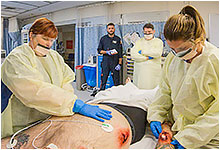Upstate University - Trauma Center - Virtual Tour

The Golden Hour of Trauma Care
The purpose of this is to give an overview of the resuscitative phase of trauma care and is not intended to provide step-by-step directions for accomplishing the associated tasks.

Radio Room
Incoming EMS calls are received on the radio or on a telephone line. Calls are answered by an ER physician. ER physician or Nurse activates the trauma code.
Additional Information Related To This Image:
Video: Video Test

Donning PPE - Video Version

Donning PPE - Still Version

Trauma Positions
Additional Information Related To This Image:
Team Leader
The team leader is responsible for guiding the team and overall management of the patient. Seeks input from team members.Support/Procedure Staff
HCT – Is an RN for level 1 TTA. Can be an LPN or HCT for level 2 TTA. Responsible for tasks which will vary with credentials. Examples include manual blood pressure, log-rolling patient and applying monitor for transport.Airway Physician
An Airway Physician is responsible for managing airway, determining medications for intubation, and will perform primary and secondary assessments as they pertain to head and neckPrimary Nurse
A Primary Nurse – RN, assists with procedures, establishes IV’s, administers medications, etc.Scribe Nurse
A Scribe nurse documents care of the patient including the EMS report, patient assessment, procedures performed and results of all treatments.Procedure Physician
A Procedure physician performs surgical procedures on this side of the patient. Position is at the side of the trauma stretcher, next to the primary nurseAssessment Physician
The Assessment Physician coordinates overall assessments. And performs physician or surgical procedures on this side of patient.
Trauma Room
Additional Information Related To This Image:
Storage room
Contains procedural trays and blanket warmer.Pyxis Medication Machine
For medication dispensing.Belmont Rapid Infuser
Used to warm and rapidly infuse blood.TV Monitor
For viewing images from portable x-ray machine.Scribe Computer
Used to document on patient in trauma narrator.Monitor
For specific patient information viewingTrauma Supply Carts
Contains equipment and supplies for use during a trauma code.Glidescope
Fiber optic laryngoscope.Difficult Airway Cart
Cardiac Monitor
Can also be used for oxygen saturation, temperature, and end tidal CO2.Floor Circles
Blood Refrigerator
Containing 2 units O Negative BloodVentilator
Stretcher/Slider Board
Equipment and Supply Omnicell
Items include, but not limited to cervical collars, thoracotomy supplies, REBOA, and central line kits.Ultrasound Machine for FAST exam
PPE supplies and role stickers
Computer
Used by Residents and Advanced Practitioners to document and enter physician ordersBroselow Cart

Primary Assessment
Additional Information Related To This Image:
External hemorrhage will be controlled with the use of direct pressure, wound packing, and/or placement of a tourniquet. Initial fluid/blood resuscitation is started.
A = Alertness and Airway
The airway must be secured prior to assessing breathing. Interventions may include endotracheal intubation, or placement of a surgical airway.
B = Breathing
Adequate oxygenation and ventilation are extremely important. Supplemental oxygen is often needed and administered via mask or ventilator if patient is intubated. Tension pneumothoraces and massive hemothoraces are life-threatening and require chest tube placement prior to assessing circulation.
C = Circulation
Fluid/blood replacement is initiated (exception of uncontrolled external hemorrhage where this is started prior to airway).
D = Disability
Assesses the neurological status of the patient. Includes Glascow Coma Scale (GCS) and movement and sensation in the extremities.
E = Exposure and Environment
Patient needs to be completely exposed to look for injuries. Body temperature must be maintained as hypothermic patients can become coagulopathic. Methods to maintain room temperature include closing the door and increasing ambient room temperature; warm blankets and/or warmed IV fluids or blood.
Adjuncts to the primary survey include chest x-ray, pelvic x-ray, and FAST exam.
A pelvic binder should be placed at this time for evidence of an open-book fracture.
The CABCDE Approach
C = Uncontrolled External HemorrhageExternal hemorrhage will be controlled with the use of direct pressure, wound packing, and/or placement of a tourniquet. Initial fluid/blood resuscitation is started.
A = Alertness and Airway
The airway must be secured prior to assessing breathing. Interventions may include endotracheal intubation, or placement of a surgical airway.
B = Breathing
Adequate oxygenation and ventilation are extremely important. Supplemental oxygen is often needed and administered via mask or ventilator if patient is intubated. Tension pneumothoraces and massive hemothoraces are life-threatening and require chest tube placement prior to assessing circulation.
C = Circulation
Fluid/blood replacement is initiated (exception of uncontrolled external hemorrhage where this is started prior to airway).
D = Disability
Assesses the neurological status of the patient. Includes Glascow Coma Scale (GCS) and movement and sensation in the extremities.
E = Exposure and Environment
Patient needs to be completely exposed to look for injuries. Body temperature must be maintained as hypothermic patients can become coagulopathic. Methods to maintain room temperature include closing the door and increasing ambient room temperature; warm blankets and/or warmed IV fluids or blood.
Adjuncts to the primary survey include chest x-ray, pelvic x-ray, and FAST exam.
A pelvic binder should be placed at this time for evidence of an open-book fracture.

Secondary Assessment
Additional Information Related To This Image:
A = allergies
M = medications
P = Past Medical History
L = last oral intake
E = events leading up to the current presentation (history of presenting injury or illness).
Vital Signs-complete set of vital signs, including Glascow Coma Scale (GCS).
Head-to-toe assessment is the systematic assessment of the patient looking for abnormalities. After the completion of the head-to-toe assessment, treatment is prioritized based upon severity of the injuries found.
SAMPLE History
S = signs or symptomsA = allergies
M = medications
P = Past Medical History
L = last oral intake
E = events leading up to the current presentation (history of presenting injury or illness).
Vital Signs-complete set of vital signs, including Glascow Coma Scale (GCS).
Head-to-toe assessment is the systematic assessment of the patient looking for abnormalities. After the completion of the head-to-toe assessment, treatment is prioritized based upon severity of the injuries found.

